 |
 |
The last living exponent of the traditional
Korean Tight-rope Performance
The traditional repertoire has been transmitted to Kim Tae-Gyun through a long row of masters and goes far beyond the mere display of gymnastic skill in remaining balanced on a rope. Throughout the performance, the artist maintains a steady stream of talk directed at the audience, of banter exchanged with the team of musicians that accompany him, and the full performance includes several lengthy songs, for one of which the artist dons a monk's robe.
At the same time, Kim Dae-Gyun amazes audiences
with his ability to stay on the rope aided only by a fan which he inherited
from his Master. He not only walks and runs to and fro, he bounces high
into the air, sometimes twisting through 180 degrees as he does so, he
crawls across on his knees, he sits cross-legged in the middle of the rope,
and even stretches out his legs in a quite astonishing show of control
that can only be explained by the fact that he began to practice on the
rope when he was still a child, after seeing performances by the
man who was to be his master. (Read a longer text about Kim
Dae-Gyun.)
(If you can read Korean, you will want to visit his Korean-language
Home Page (use MSExplorer, not Netscape). It has an English-language
section with sections copied from this site but it is not being maintained)
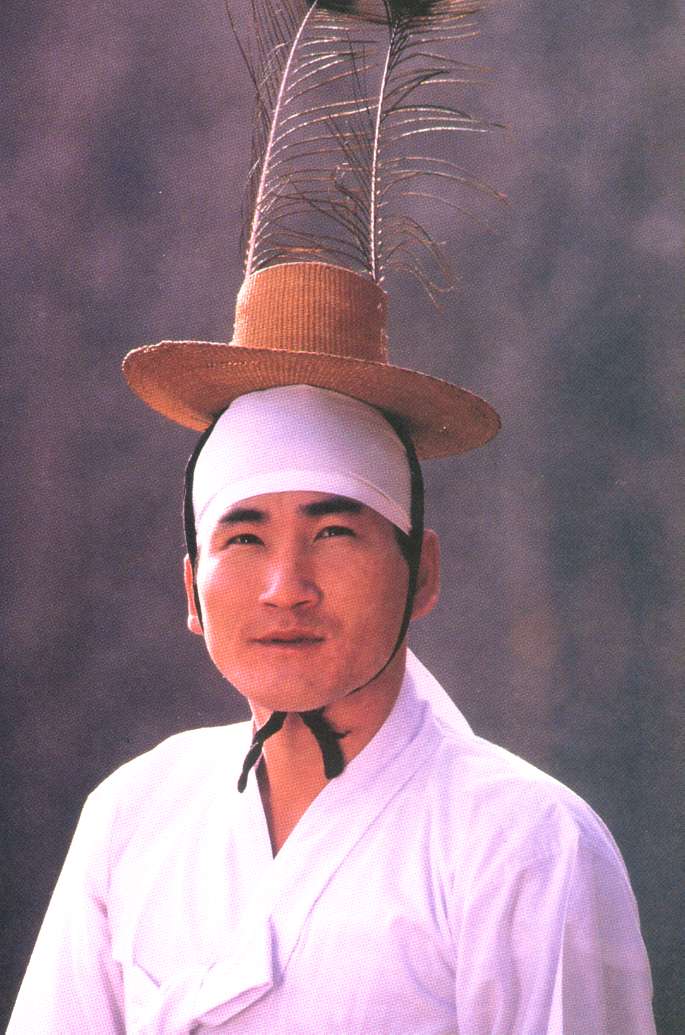 |
|
Kim Dae-Gyun writes : Twenty years have passed since I first mounted onto the rope, a mere 8-year-old child ignorant of everything. More than ten years ago my teacher, Master Kim Yong-ch'ol, died, and since then my life has often been lonely and hard. I felt overwhelmed by the enormity of the task of preserving and maintaining the traditional form of Tight-rope performing all alone, without any master, bearing the burden of 1300 years. In the midst of that sense of oppression, the only reason why I went on climbing onto the rope was the dream I had of a glorious revival of the great art, 1300 years old, of traditional Tight-rope Performing : it was once known as the 'finest flower of popular performing arts,' had been performed before kings, and had enjoyed the highest esteem of society in days gone by. What is Tight-rope Performing today? People today seem unable to distinguish it from acrobatic and circus tight-rope acts, a sign that we are living in an age that is lost and confused about traditional culture as a whole. To enable Korean culture to stand proudly at the very heart of world culture in this new millennium, a new Age of Culture, to be able to set up my poles and walk my rope in celebration of the glorious revival of our tradition, I have prepared a repertoire for my own very special journey into the new millennium. All of us who are working for the preservation of traditional Tight-rope Performing in Korea invite you to accompany us on our journey. Kim Dae-Gyun
He always begins a performance by making offerings of food and drink, praying for all who will see the performance, and offering his skills. |

|
|
Invocation Before a Performance Today before this distinguished audience there is to be a performance of our Korean Tight-rope Walking, as it has been handed down through 1300 years. It is now more than twenty years since the art of Tight-rope Walking was designated an Intangible Cultural Treasure, yet of all the traditional Korean folk-arts it is the most endangered. Master Kim Sang-bong, celebrated for having performed on the rope before the king 200 years ago, Master Ch'oi Sang-ch'on, Master Kim Yong-ch'ol who considered me as another self, and Master Lee Dong-an, the last holder of the title of Treasure in our time : today I am to perform for this distinguished audience, so grant me to perform well, and may the homes and families of everybody here be filled with laughter and merriment. The Invocation before a Performance is presented to the God of Heaven
and Earth with invocation of previous Masters of the Tightrope, praying
for a good performance.
|
|
|
| The Tight-rope Performance
The rope is fixed to stakes driven into the ground at either end of the performing area. It is raised some 2 yards or more into the air by two props, each made of two long poles lashed in an 'X'. On the ground directly below the middle of the rope, a table with candles and offerings of food and wine is prepared. The musicians who will accompany the performance take their places on a straw mat near the rope. The performer (and his clown-partner if there is one) make offerings of wine and perform the invocation, share out the food to the spectators, and then he climbs the rope to a musical accompaniment. Once the performer has reached the first prop, he demands silence, the music stops and he embarks on various kinds of witty dialogue to which the clown or the musicians respond. Between the sections of dialogue the performer sings a number of traditional ballads, T'aryong, including the Monk T'aryong, the Bird T'aryong, etc and executes various displays of skill, of which the repertoire numbers some 40 different kinds. After all this comes the climax of the performance, the Salp'an in which the performer walks backward along the rope, bounces high into the air, and finally executes a complete turn while in the air, before sitting cross-legged on the rope in the most dangerous moment and the greatest challenge to his ability. At the start of the Salp'an the performer remarks that if he makes a mistake, it will turn into a Chugulp'an, a pun implying that his very life is in danger. With the end of the Salp'an, the performance is over.
|
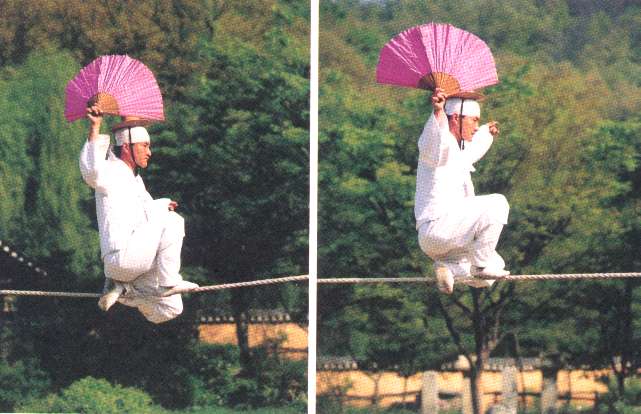 |
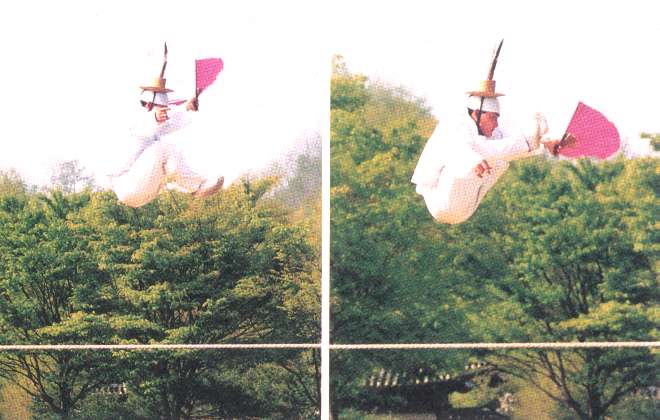 |
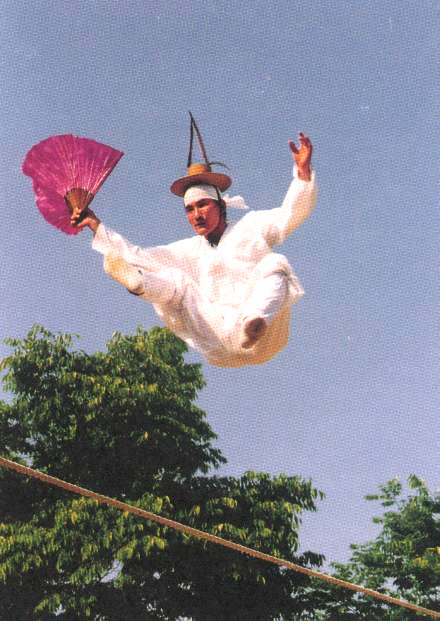 |
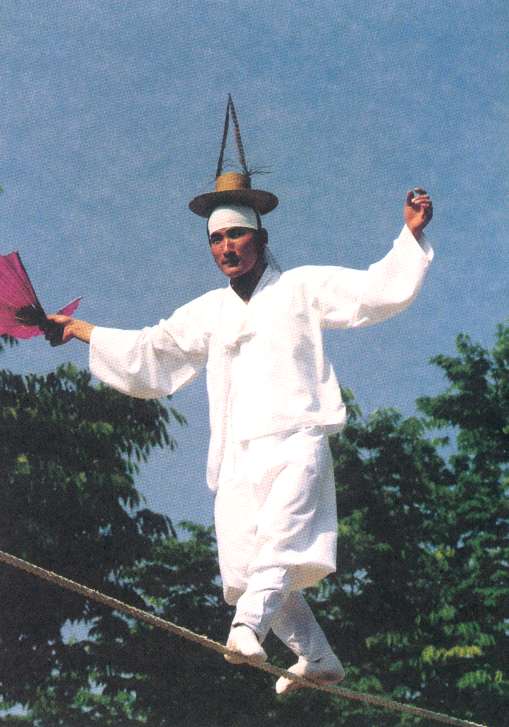 |
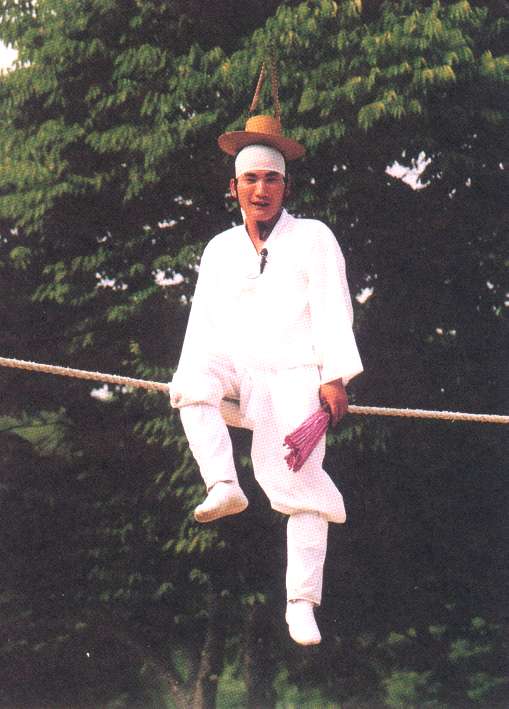 |
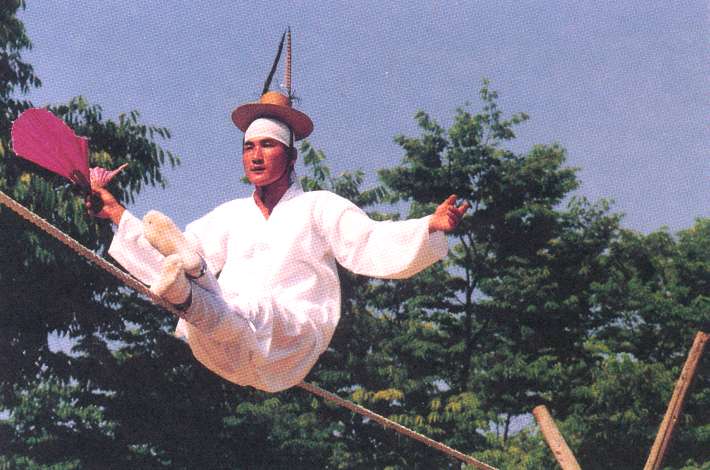 |
The Committee for the Preservation of Tight-rope Performing writes :
In the coming new Millennium we are resolved to :
1. Promote performances throughout Korea to raise the general popularity
of Tight-rope Performing.
2. Promote performances and workshops abroad, once the theoretical
bases have been clearly established.
3. Establish an effective Supporting Committee.
4. Establish Tight-rope Performing as a special field of study.
5. Ensure the future transmission of the Art of Tight-rope Performing
at both basic and professional levels through special training camps.
6. Raise the status of the Committee for the Preservation of Tight-rope
Performing from a purely private initiative to that of an official group
with proper legal status.
7. Organize a World Tight-rope Festival to mark the start of the new
Millennium, with participants from many countries.
8. Organize performances for Koreans working on overseas industrial
projects.
At the start of the new millennium, the Committee for the Preservation of Tight-rope Performing invites you all to join us on this very special journey.
We ask you to participate either by your personal involvement or by financial support.
